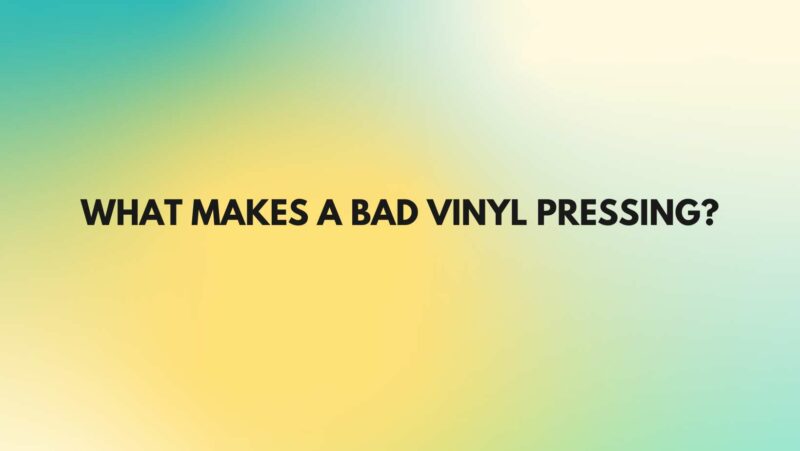Vinyl records have enjoyed a resurgence in popularity, captivating audiophiles and music enthusiasts with their tactile charm and warm, analog sound. However, not all vinyl pressings are created equal, and collectors occasionally encounter the frustration of a bad vinyl pressing. In this comprehensive article, we will dissect the elements that contribute to a bad vinyl pressing, the consequences it has on audio quality, and steps that can be taken to identify, prevent, and address such issues.
Section 1: What Constitutes a Bad Vinyl Pressing?
A bad vinyl pressing can manifest in several ways, each negatively impacting the listening experience. Common characteristics include:
- Surface Noise: Audible clicks, pops, crackles, and hisses that distract from the music.
- Non-Fill: Incomplete grooves result in parts of the music being skipped or muted during playback.
- Warps: Physical deformities in the vinyl cause the needle to bounce or skip, rendering the record unplayable.
- Off-Center Holes: Misalignment of the spindle hole leads to wobbly playback, affecting pitch and sound quality.
- Impurities: Mold spots, streaks, or other contaminants on the vinyl can interfere with audio reproduction.
Section 2: Causes of Bad Vinyl Pressings
Understanding the root causes of bad pressings is crucial for both collectors and industry professionals. Common factors include:
- Quality Control Issues: Insufficient quality control measures during the pressing process may lead to defects going unnoticed.
- Overproduction: High demand for vinyl has pressured some pressing plants to prioritize quantity over quality, resulting in rushed and error-prone production.
- Inferior Materials: The use of recycled or low-quality vinyl materials can lead to pressing issues, including non-fill and impurities.
- Overcrowding and Backlogs: Some pressing plants may overextend their capacity to meet demand, leading to rushed and subpar production.
Section 3: The Consequences of Bad Pressings
The consequences of a bad vinyl pressing are twofold: they impact both the collector’s listening experience and the reputation of vinyl records as a high-quality audio format.
- Diminished Listening Experience: Surface noise, non-fill, warps, and other defects can significantly detract from the enjoyment of the music, making it distracting and frustrating.
- Damage to the Vinyl Community: Bad pressings can erode trust in vinyl as a format, leading some collectors to become disillusioned and opt for digital alternatives.
Section 4: Identifying and Preventing Bad Pressings
For vinyl enthusiasts, identifying and preventing bad pressings is vital for preserving the integrity of their collections:
Identifying Bad Pressings:
- Visual Inspection: Before purchasing, inspect the record for visible defects, warps, or off-center holes. Request photos when buying online.
- Research Labels and Pressing Plants: Research record labels and pressing plants known for their quality control and attention to detail.
- Collectors’ Communities: Online vinyl collectors’ communities often share experiences and reviews of specific releases, including any pressing issues.
Preventing Bad Pressings:
- Buy from Reputable Sources: Purchase vinyl records from reputable record stores and labels, as they are more likely to prioritize quality.
- Invest in High-Quality Equipment: High-quality turntables, cartridges, and styluses can sometimes compensate for minor pressing imperfections.
- Support Labels with Quality Control: Support record labels that prioritize quality control and customer satisfaction.
Section 5: Addressing Bad Pressings
If you’ve acquired a bad vinyl pressing, consider these steps for addressing the issue:
- Return or Exchange: Contact the seller or label to inquire about returning or exchanging the record.
- Professional Cleaning: Surface noise caused by impurities or dust can often be mitigated through professional cleaning services that specialize in vinyl record restoration.
- Replacement Policy: Some labels and record stores have replacement policies for defective records, so inquire about these policies when making a purchase.
Conclusion
A bad vinyl pressing is a frustrating experience that can detract from the enjoyment of vinyl records and cast doubts on the format’s quality. By understanding the causes, consequences, and prevention strategies associated with bad pressings, collectors can make informed decisions and preserve the essence of vinyl records as a cherished medium for music enjoyment. Additionally, industry professionals must prioritize quality control and customer satisfaction to uphold the reputation of vinyl in the modern audio landscape.


